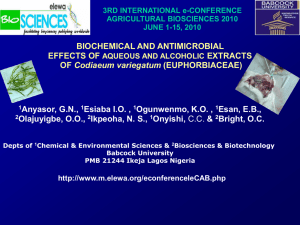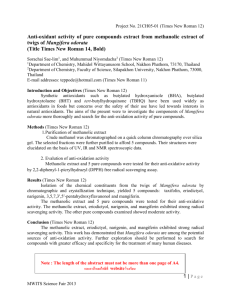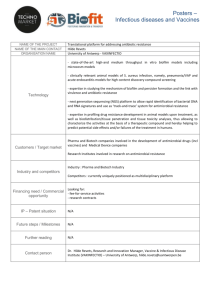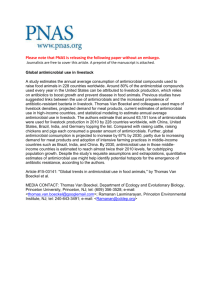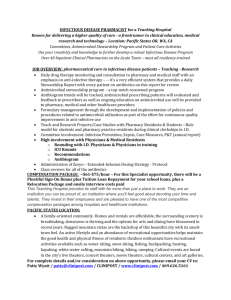Antimicrobial activities of four medicinally important plants
advertisement
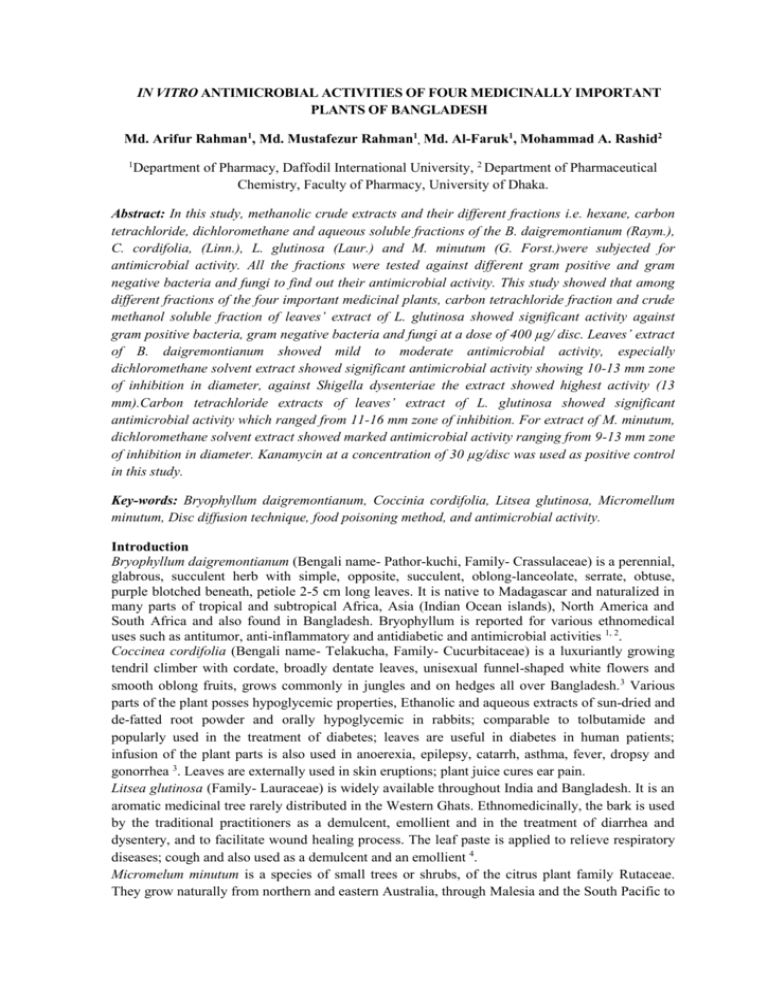
IN VITRO ANTIMICROBIAL ACTIVITIES OF FOUR MEDICINALLY IMPORTANT PLANTS OF BANGLADESH Md. Arifur Rahman1, Md. Mustafezur Rahman1, Md. Al-Faruk1, Mohammad A. Rashid2 1 Department of Pharmacy, Daffodil International University, 2 Department of Pharmaceutical Chemistry, Faculty of Pharmacy, University of Dhaka. Abstract: In this study, methanolic crude extracts and their different fractions i.e. hexane, carbon tetrachloride, dichloromethane and aqueous soluble fractions of the B. daigremontianum (Raym.), C. cordifolia, (Linn.), L. glutinosa (Laur.) and M. minutum (G. Forst.)were subjected for antimicrobial activity. All the fractions were tested against different gram positive and gram negative bacteria and fungi to find out their antimicrobial activity. This study showed that among different fractions of the four important medicinal plants, carbon tetrachloride fraction and crude methanol soluble fraction of leaves’ extract of L. glutinosa showed significant activity against gram positive bacteria, gram negative bacteria and fungi at a dose of 400 µg/ disc. Leaves’ extract of B. daigremontianum showed mild to moderate antimicrobial activity, especially dichloromethane solvent extract showed significant antimicrobial activity showing 10-13 mm zone of inhibition in diameter, against Shigella dysenteriae the extract showed highest activity (13 mm).Carbon tetrachloride extracts of leaves’ extract of L. glutinosa showed significant antimicrobial activity which ranged from 11-16 mm zone of inhibition. For extract of M. minutum, dichloromethane solvent extract showed marked antimicrobial activity ranging from 9-13 mm zone of inhibition in diameter. Kanamycin at a concentration of 30 µg/disc was used as positive control in this study. Key-words: Bryophyllum daigremontianum, Coccinia cordifolia, Litsea glutinosa, Micromellum minutum, Disc diffusion technique, food poisoning method, and antimicrobial activity. Introduction Bryophyllum daigremontianum (Bengali name- Pathor-kuchi, Family- Crassulaceae) is a perennial, glabrous, succulent herb with simple, opposite, succulent, oblong-lanceolate, serrate, obtuse, purple blotched beneath, petiole 2-5 cm long leaves. It is native to Madagascar and naturalized in many parts of tropical and subtropical Africa, Asia (Indian Ocean islands), North America and South Africa and also found in Bangladesh. Bryophyllum is reported for various ethnomedical uses such as antitumor, anti-inflammatory and antidiabetic and antimicrobial activities 1, 2. Coccinea cordifolia (Bengali name- Telakucha, Family- Cucurbitaceae) is a luxuriantly growing tendril climber with cordate, broadly dentate leaves, unisexual funnel-shaped white flowers and smooth oblong fruits, grows commonly in jungles and on hedges all over Bangladesh. 3 Various parts of the plant posses hypoglycemic properties, Ethanolic and aqueous extracts of sun-dried and de-fatted root powder and orally hypoglycemic in rabbits; comparable to tolbutamide and popularly used in the treatment of diabetes; leaves are useful in diabetes in human patients; infusion of the plant parts is also used in anoerexia, epilepsy, catarrh, asthma, fever, dropsy and gonorrhea 3. Leaves are externally used in skin eruptions; plant juice cures ear pain. Litsea glutinosa (Family- Lauraceae) is widely available throughout India and Bangladesh. It is an aromatic medicinal tree rarely distributed in the Western Ghats. Ethnomedicinally, the bark is used by the traditional practitioners as a demulcent, emollient and in the treatment of diarrhea and dysentery, and to facilitate wound healing process. The leaf paste is applied to relieve respiratory diseases; cough and also used as a demulcent and an emollient 4. Micromelum minutum is a species of small trees or shrubs, of the citrus plant family Rutaceae. They grow naturally from northern and eastern Australia, through Malesia and the South Pacific to Antimicrobial activities of four medicinally important plants Page | 2 Indochina and India. They grow as an understorey plants in humid forests including rainforest, montane forest and gallery forest. The species has traditionally been used medicinally throughout its range and recent scientific analysis has revealed a range of physiologically active compounds including anticoagulants, anti-carcinogens and anti-bacterials 5.In the present paper, we analyze the past, present and future of medicinal plants, both as potential antimicrobial crude drugs as well as a source for natural compounds that act as new anti-infection agents. MaterialsandMethodsCollection and Preparation of the Plant Materials:The leaves of Bryophyllum daigremontianum (Family: Crassulaceae),Coccinea cordifolia, (Family: Cucurbitaceae),Litsea glutinosa (Family: Lauraceae) and Micromelum minutum (Family: Rutaceae) were collected from Dhaka, Bangladesh, in June, 2009. The voucher specimens for these collections have been deposited in Bangladesh National Herbarium, Mirpur, Dhaka. The leaves of the plants were first separated from the plant, cut into small pieces and air-dried for several days. The pieces were then oven dried in an oven for 24 hours at considerably low temperature to facilitate grinding Extraction and Fractionation The sun dried and powdered leaves of 500 gm of each plant were separately extracted with methanol (500 ml) for 15 days at room temperature with occasional shaking and stirring. It was then filtered through a cotton plug followed by Whatman filter paper number 1. The extracts were concentrated with a rotary evaporator at low temperature (40-45 ºC) and reduced pressure. Subsequent evaporation of solvents afforded extract of B. daigremontianum (7.3 g),C.cordifolia, (6.5 g), L. glutinosa (5.2 g), and M. minutum (6.9 g).An aliquot (5 gm) of the concentrated methanolic extract from each plant was partitioned by the modified Kupchan method 6 to provide n-hexane (HSP), carbon tetrachloride (CTP), dichloromethane (DMSF) soluble fractions. The aqueous (ASP) soluble fraction of each plant was also used for the experimental purpose. Test Organisms Both gram positive (Bacillus cereus, Bacillus megaterium, Bacillus subtilis, Sarcina lutea, Staphylococcus aureus) and gram negative bacteria (Escherichia coli, Salmonella paratyphi, Salmonella typhi, Shigella boydii, Shigella dysenteriae, Pseudomonas aeruginosa, Vibrio mimicus, Vibrio parahemolyticus), as well as fungal (Aspergillus niger, Candida albicans, Sacharomyces cerevaceae) strains were used for the experiment which were collected as pure cultures from the Institute of Nutrition and Food Science (INFS), University of Dhaka, Bangladesh. Experimental Procedure The antimicrobial study was carried out by disc diffusion technique for bacteria 7 and food poisoning method for fungi [8]. Standard Kanamycin disc (30 µg/disc) and discs containing the test materials (400 µg/disc) impregnated with the respective solvents were used as positive and negative controls, respectively. According to these methods, the antimicrobial potency of the test samples was measured by determining the diameter of the zones of inhibition in millimeter. DAFFODIL INTERNATIONAL UNIVERSITYJOURNAL OF ALLIED HEALTH SCIENCES. Volume 1, Issue 1, January 2014 Page | 3 Antimicrobial activities of four medicinally important plants Results This study showed that among different fractions of the four important medicinal plants, carbon tetrachloride fraction and Crude methanol soluble fraction of leaves’ extract of L. glutinosa showed significant activity against gram positive bacteria, gram negative bacteria and fungi at a dose of 400 µg/ disc. Results of all the extracts and fractions of the mentioned medicinally important plants are presented in Table 1-4. Table 1: Antimicrobial activity of different fractions of B. daigremontianum Test microorganisms Gram positive bacteria Bacillus cereus Bacillus megaterium Bacillus subtilis Staphylococcus aureus Sarcina lutea Gram negative bacteria Escherichia coli Pseudomonas aeruginosa Salmonella paratyphi Salmonella typhi Shigella boydii Shigella dysenteriae Vibrio mimicus Vibrio parahemolyticus Fungi Candida albicans Aspergillus niger Sacharomyces cerevacae Diameter of zone of inhibition (mm) HSF CTSF DMSF CME AQF Kanamycin 8 8 11 8 8 9 10 10 12 7.0 7.2 7.1 33.5 35.3 35.1 8 8 10 7.5 - 9 8 10 8.5 - 34.2 8 8 12.2 7.1 - 35.3 8 10 12 7.3 8 8 8.5 10 8 8 7 7 8 8 7.8 8.5 7.8 8.6 - 8.2 8.6 8.2 13 6.8 8 8 - 6.3 82 10 8 10 7.7 12 8.2 8.1 7.0 7 10.7 8.2 - 34.2 31.2 30.6 32.7 33.8 32.5 32.4 33.3 31.4 30.3 34.6 HSF=n-Hexane soluble fraction of methanolic extract DMSF=Dichloromethane soluble fraction of methanolic extract CTSF=Carbontetrachloride soluble fraction of methanolic extract CME=Crude methanolic extract AQF=Aqueous fraction of methanolic extract DAFFODIL INTERNATIONAL UNIVERSITYJOURNAL OF ALLIED HEALTH SCIENCES. Volume 1, Issue 1, January 2014 Page | 4 Antimicrobial activities of four medicinally important plants Table 2: Antimicrobial activity of different fractions of C. cordifoli Diameter of zone of inhibition (mm) Test microorganisms HSF CTSF DMSF CME AQF Kanamycin Gram positive bacteria Bacillus cereus 10 9 - 12 - 33 Bacillus megaterium 8.6 10 11 11 - 35 Bacillus subtilis 10.2 10 10 10 - 35 Staphylococcus aureus 11.4 9 9 11 - 34 Sarcina lutea 8.6 10 8 9 - 34 Escherichia coli 9.5 10 10.2 10 - 35 Pseudomonas aeruginosa 9.8 9 8.7 10 Salmonella paratyphi 8.5 8 8.8 9 - 30 Salmonella typhi 8.2 8 8.5 9 - 32 Shigella boydii 8.5 9 9 9 - 33 Shigella dysenteriae 10 10 8.6 9 - 32 Vibrio mimicus 8.5 9 8 9 - 32 Vibrio parahemolyticus 10.2 11 11 12 - 33 Candida albicans 9.2 -10 9 10 - 31 Aspergillus niger 9.8 9 8 11 - 30 Sacharomyces cerevacae 9 11 10 11 Gram negative bacteria - 31 Fungi - 34 HSF=n-Hexane soluble fraction of methanolic extract DMSF=Dichloromethane soluble fraction of methanolic extract CTSF=Carbontetrachloride soluble fraction of methanolic extract CME=Crude methanolic extract AQF=Aqueous fraction of methanolic extract DAFFODIL INTERNATIONAL UNIVERSITYJOURNAL OF ALLIED HEALTH SCIENCES. Volume 1, Issue 1, January 2014 Page | 5 Antimicrobial activities of four medicinally important plants Table 3: Antimicrobial activity of different fractions of L. glutinosa Test microorganisms Gram positive bacteria Bacillus cereus Bacillus megaterium Bacillus subtilis Staphylococcus aureus Sarcina lutea Gram negative bacteria Escherichia coli Pseudomonas aeruginosa Salmonella paratyphi Salmonella typhi Shigella boydii Shigella dysenteriae Vibrio mimicus Vibrio parahemolyticus Fungi Candida albicans Aspergillus niger Sacharomyces cerevacae Diameter of zone of inhibition (mm) HSF CTSF DMSF CME AQF Kanamycin 8.5 8.6 11 11 14 13 7.8 7.5 7.6 11 11 11 32.5 34.4 35 11.4 13 8 12 7.5 7.0 7.4 7.8 9.6 12 7.0 12 7.6 33 10. 14 8 11 7.4 35 10 14 7 10 9.5 9.2 10 10.5 10 13 14 13 13 15 7.8 7.5 7.8 8.6 8 12 11 12 13 11 12 15 - 11 11 10 12 13 7.7 8.8 12 12 10 13 8.7 10 7.5 7.7 7.2 7.5 7.5 7.4 7.6 7.2 7.8 7.5 34 31 30 32 33 32 32 33 32 30 32 HSF=n-Hexane soluble fraction of methanolic extract DMSF=Dichloromethane soluble fraction of methanolic extract CTSF=Carbontetrachloride soluble fraction of methanolic extract CME=Crude methanolic extract AQF=Aqueous fraction of methanolic extract DAFFODIL INTERNATIONAL UNIVERSITYJOURNAL OF ALLIED HEALTH SCIENCES. Volume 1, Issue 1, January 2014 Page | 6 Antimicrobial activities of four medicinally important plants Table 4: Antimicrobial activity of different fractions of M. minutum Test microorganisms Gram positive bacteria Bacillus cereus Bacillus megaterium Bacillus subtilis Staphylococcus aureus Sarcina lutea Gram negative bacteria Escherichia coli Pseudomonas aeruginosa Salmonella paratyphi Salmonella typhi Shigella boydii Shigella dysenteriae Vibrio mimicus Vibrio parahemolyticus Fungi Candida albicans Aspergillus niger Sacharomyces cerevacae Diameter of zone of inhibition (mm) HSF CTSF DMSF CME AQF Kanamycin 10.5 8.6 11 - 11 11 12 10 8 11 - 33.5 35.3 35.1 11.4 - 9 9 8.6 - 12 11 - 10.5 - 12.2 11 - 12.8 - 11.7 12 9.5 9.2 9.5 10.5 11 - 8.8 9.5 10.8 10.6 12 10 9 9 9.5 6.8 10 - 8 6.3 11 8.8 - 7.7 10.8 12 8.1 9.0 - 10.7 8.2 - - 34.2 34.2 35.3 31.2 30.6 32.7 33.8 32.5 32.4 33.3 31.4 30.3 34.6 HSF=n-Hexane soluble fraction of methanolic extract DMSF=Dichloromethane soluble fraction of methanolic extract CTSF=Carbontetrachloride soluble fraction of methanolic extract CME=Crude methanolic extract AQF=Aqueous fraction of methanolic extract Discussion Leaves’ extract of B. daigremontianum showed mild to moderate antimicrobial activity, (Table 1) especially dichloromethane solvent extract showed significant antimicrobial activity showing 1013mm zone of inhibition in diameter, against S. dysenteriae the extract showed highest activity (13 mm).Moderate activity was shown against B. Subtilis, P. aeruginosa and A. niger (12 mm each). In case of C. cordifoli, it too showed mild to moderate antimicrobial activity and its methanolic extract showed significant antimicrobial activity (Table 2) that ranged from 9-12 mm zone of inhibition in diameter in which high activity was shown against B. cereus (12 mm) and V. parahemolyticus (12 mm). This extract did not show notable antimicrobial activity against others. DAFFODIL INTERNATIONAL UNIVERSITYJOURNAL OF ALLIED HEALTH SCIENCES. Volume 1, Issue 1, January 2014 Antimicrobial activities of four medicinally important plants Page | 7 Carbon tetrachloride extracts of leaves’ extract of L. glutinosa showed significant antimicrobial activity (Table 3) which ranged from 11-16 mm zone of inhibition. Notable antimicrobial activity was shown against gram positive bacteria like B. megaterium (14 mm), B. Subtilis (13 mm), S. aureus (13 mm) and gram negative bacteria like E. coli(14 mm), P. aeruginosa (14 mm), S. typhi (14 mm), V. mimicus (15 mm) and V. parahemolyticus (15 mm). The carbon tetrachloride extract’s antifungal activity was very significant especially against S. cerevaceae and A. niger (13 mm). For extract of M. minutum, dichloromethane solvent extract showed marked antimicrobial activity (Table 4) ranging from 9-13 mm zone of inhibition in diameter. And this plant showed mild to moderate antimicrobial activity. Against gram positive bacteria, especially S. Lutea, thisextract showed quite better antimicrobial activity (12 mm). Noteworthy activity against gram negative bacteria was against P. aeruginosa (12.8 mm). Activity against others is not outstanding. Conclusion From the above results, it can be concluded that all the plants have great potential to act as antioxidant, which also indicates the presence of secondary metabolites having antioxidant activities. These plants may be tried indepth study. References 1. 2. 3. 4. 5. 6. Ojewole, J.A. Antinociceptive, anti-inflammatory and antidiabetic effects of Bryophyllum pinnatum (Crassulaceae) leaf aqueous extract. 2005, J. Ethnopharmacol. 99, 13-19. Akinpelu, D.A. Antimicrobial activity of Bryophyllum pinnatum leaves. 2000, Fitoterapia71, 193194. Ghani A. Medicinal Plants of Bangladesh with Chemical Constituents and Uses. 2003, 2nd Ed. (Asiatic miliitary press, Dhaka, 1000) pp 350-351 Pradeepa, K.; Krishna, V.; Kumar, K. Girish; Thirumalesh, B. V.; Kumar, K. J. Naveen, Antibacterial screening of the stem bark and leaf extracts of Litsea glutinosa (Lour.) C.B. Rob-an ethnomedicinally important tree of the Western Ghats. 2011, Pharmacognosy Journal; Vol. 3 Issue 21, p72 Cambie, R. C.; Ash, J. Fijian Medicinal Plants (Google books link). CSIRO Publishing. 1994 pp. 2031–2. ISBN 0643102957; Van Wagenen., B.C., Larsen, R., Cardellina, J.H. II, Ran dazzo, D., Lidert, Z.C. and Swithenbank, C. 1993. Ulosantoin, a potent insecticide from the sponge Ulosa ruetzleri. J. Org. Chem. 58, 335337. DAFFODIL INTERNATIONAL UNIVERSITYJOURNAL OF ALLIED HEALTH SCIENCES. Volume 1, Issue 1, January 2014
